
Personalization with DNA profiles
DNAklik has developed a method to generate DNA profiles for data objects and visitors to the website. This method is especially suitable for websites with a large collection of items. By matching DNA profiles, suggestions can be made to find similar items or users with common interests.
Principle of the method
DNA profiles are built up through the selection of content from the website visitors. By means of the exchange of the DNA building blocks between the DNA profile of the user and the DNA profile of the content, DNA profiles are created for users and content items. Similar content gets DNA profiles that are similar to each other, as well as visitors with similar interests. These profiles can be used for:
- Finding similar items
- Connecting web visitors with similar interests
- Giving suggestions of interesting items to website visitors
- Organize a collection
Because the DNA profiles are constantly changing, so do the suggestions. This is ideal for discovering new, interesting information. Unlike an exact search command or the use of an index or tag system, relationships can arise between similar content. This is reflected in the prototype (see DNA profiles) where matching also arises between, for example, red with orange and rose. This is in contrast to a tag or index system, where there is never a match between red and another colour.
Organize collections
To make digital collections searchable, they must be provided with metadata. Especially if the digital collection does not consist of texts but of photos, films or sounds, it cannot be organized if no metadata is linked to the data files. Even if the metadata is incomplete or inconsistent, this collection can be difficult to search. With the method described here, it is possible to unlock these collections.
Prototype with colours
Dna profiles show a prototype of this system. The content consists of 4096 colours. This collection represents a collection without metadata. By instructing users to select the colour that best matches a pre-chosen colour in a screen with 30 colours, DNA profiles are built up for the user and the colour. The screen is filled with 24 colours that best match the DNA profile of the user and the chosen colour.
You can participate in the test by taking a colour in mind and looking for the colour by always choosing the colour that best matches it. If you want to switch to a different colour, you can remove Your DNA and start over again. By clicking on "items" you will see colours that best match your personal DNA stored in a cookie. You can also create an account or different accounts, then your profile will be saved, and you can continue later and follow the system properly.
Improved customer experience
The principle of this method is fundamentally different from personalization techniques where extensive data (via tracking, mining and data analyses) is collected from users. The advantage of this is:
- No need to determine which data is relevant for giving suggestions
- No breach of GDPR legislation. The only thing that is stored is a DNA profile that is otherwise unusable outside the system.
- The system is relatively simple and therefore easy to implement
The system is ideal for navigating through a website with a large collection of items, e.g. a webshop or a museum collection. It is not primarily intended as a marketing strategy to achieve certain targets, but purely to help the customer to find interesting content.
I have made a demo in which this method is used to navigate through the collections of the expert sites of the Gemeente museum. There, the collections of Delft pottery, Asian ceramics and Mondrian have been combined. If you are curious how this works, please contact me.